Cisco CCNA Steps to Configuring EIGRP MD5 Authentication (continued)
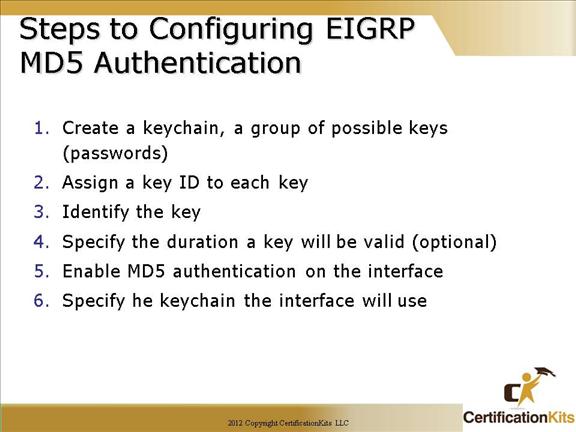
Specific commands and an example are shown on the following slide.
Cisco CCNA Configuring EIGRP MD5 Authentication (continued)
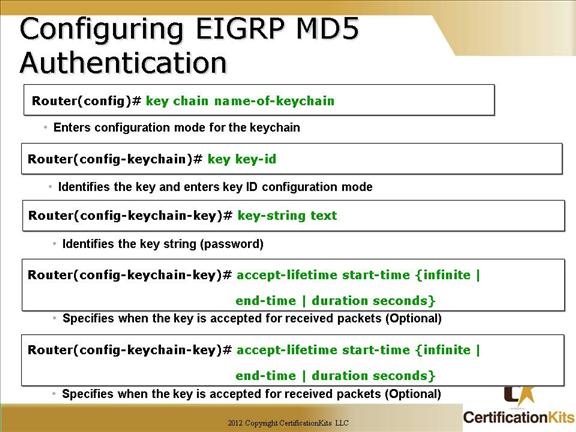
Example configuration:
Routing authentication relies on a key on a keychain to function. Before authentication can be enabled, a keychain and at least one key must be created.
Enter global configuration mode.
Dallas#configure terminal
Create the key chain. MYCHAIN is used in this example.
Dallas(config)#key chain MYCHAIN
Specify the key number. 1 is used in this example.
Note: It is recommended that the key number be the same on all routers involved in the configuration.
Dallas(config-keychain)#key 1
Specify the key-string for the key. securetraffic is used in this example.
Dallas(config-keychain-key)#key-string securetraffic
End the configuration.
Dallas(config-keychain-key)#end
Dallas#
Once you create a keychain and key, you must configure EIGRP to perform message authentication with the key. This configuration is completed on the interfaces that EIGRP is configured on.
Cisco CCNA Configuring EIGRP MD5 Authentication (continued)
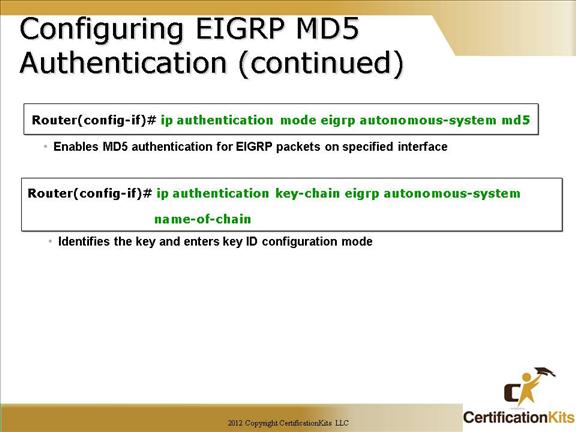
Example continued (applying to an interface):
Enter global configuration mode.
Dallas#configure terminal
Specify the interface that you want to configure EIGRP message authentication on. In this example the first interface is Serial 0/0.
Dallas(config)#interface serial 0/0
Enable EIGRP message authentication. The 10 used here is the autonomous system number of the network. md5 indicates that the md5 hash is to be used for authentication.
Dallas(config-if)#ip authentication mode eigrp 10 md5
Specify the keychain that should be used for authentication. 10 is the autonomous system number. MYCHAIN is the keychain that was created on the previous slide.
Dallas(config-if)#ip authentication key-chain eigrp 10 MYCHAIN Dallas(config-if)#end
NOTE: The same configuration will need to be performed on all routers running EIGRP in AS 10.
EIGRP MD5 Authentication can be verified using the following command:
show ip eigrp neighbors
Cisco CCNA Route Path
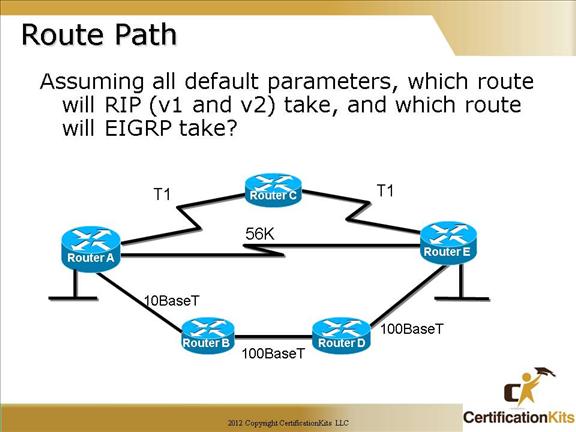
RIPv1 and RIPv2 use the same metric (hop count) and would find the 56K link the best path to the remote network.
EIGRP and IGRP each use the same metric (bandwidth and delay of the line by default) and would use the path through the LAN interfaces, not the serial T1’s or the 56K link.
As you can see while RIP takes the shortest path based on the least number of router hops, it is not always the most efficient route with regards to bandwidth and delay, in fact in this case it is by far the worst path. Since EIGRP and IGRP factors bandwidth and delay into its routing decision it chooses the path with more hops but significantly more bandwidth and less delay which is the best of the three available paths.
Cisco CCNA Verifying Enhanced IgRP Operation
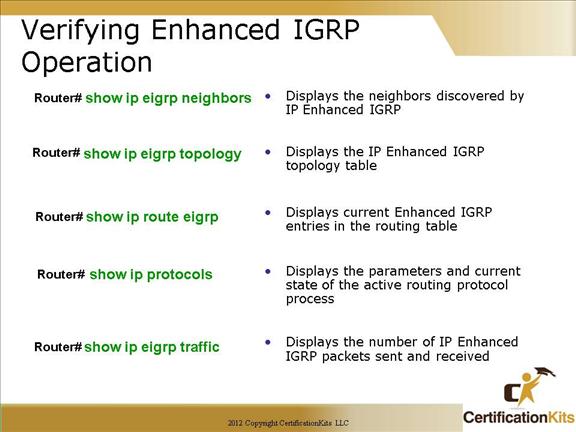
Below are several useful commands to view information about the operation of EIGRP and how it is configured.
show ip eigrp neighbors: Displays all EIGRP neighbors.
show ip eigrp topology: Displays entries in the EIGRP topology table.
show ip route eigrp: Displays only EIGRP entries in the routing table.
show ip protocols: Displays parameters and current state of active routing protocols
show ip eigrp traffic: Displays statistics pertaining to EIGRP packets sent and received.
Cisco CCNA Verifying EIGRP
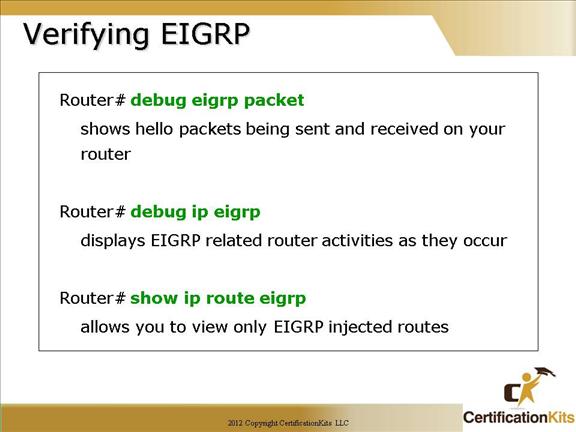
The use of debugging commands should always be used with caution in a production network as debugging is CPU intensive. With that being said the “debug eigrp packet” command will display hello packets being sent and received by the router and the “debug ip eigrp” command displays EIGRP related activity on the router.
Cisco CCNA show ip route
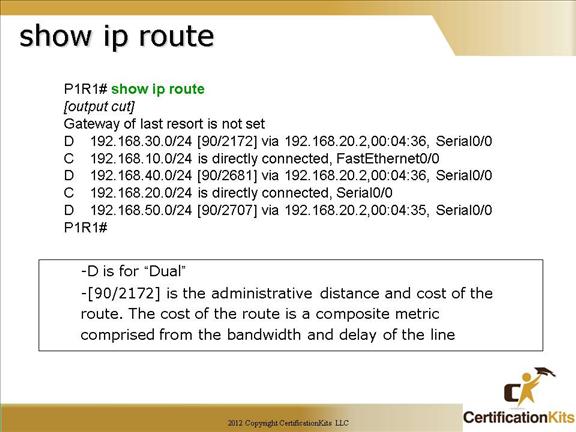
The “show ip route” command, or “show ip route eigrp” command, displays the routing table. The use of the “eigrp” option limits the routes being display to only EIGRP routes which are denoted with the “D” in front of the route which is for “Dual”, the algoritm EIGRP uses to provide loop free routing.
–
Cisco CCNA show ip eigrp topology
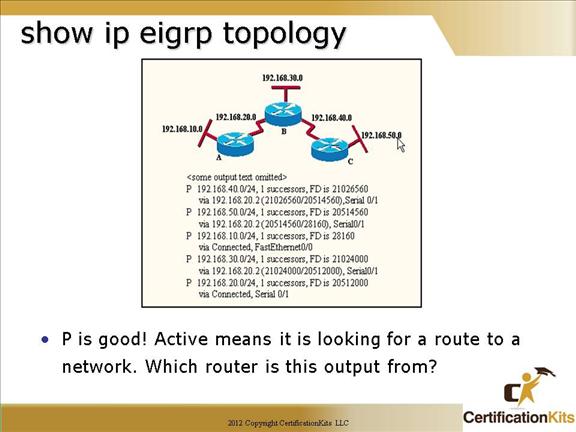
Remember this command, which shows the topology table.
Command syntax:
show ip eigrp topology [as-number | [[ip-address] mask]] [active | all-links | pending | summary | zero-successors]
as-number – (Optional) Autonomous system number.
ip-address – (Optional) IP address. When specified with a mask, a detailed description of the entry is provided.
mask – (Optional) Subnet mask.
active – (Optional) Displays only active entries in the EIGRP topology table.
all-links – (Optional) Displays all entries in the EIGRP topology table.
pending – (Optional) Displays all entries in the EIGRP topology table that are waiting for an update from a neighbor or are waiting to reply to a neighbor.
summary – (Optional) Displays a summary of the EIGRP topology table.
zero-successors – (Optional) Displays available routes in the EIGRP topology table.
Cisco CCNA Show ip Protocols
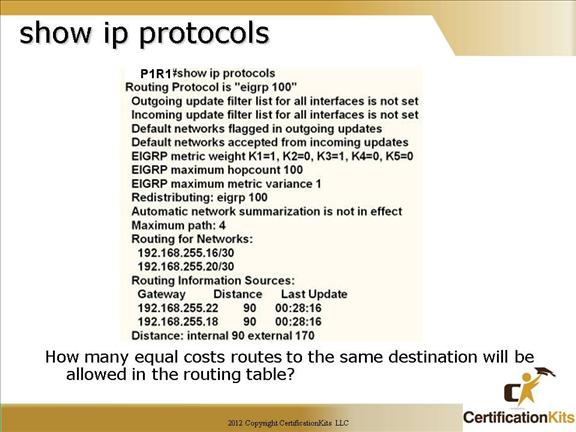
Answer:
A maximum of 4 equal cost paths indicated by the following line in the output:
Maximum path: 4 (default for EIGRP)
Note the “K” values where K1=1 and K3=1 and all other “K” values are 0. This indicates that only bandwidth and delay are taken into account when calculating the cost.
Cisco CCNA Link State vs. Distance Vector
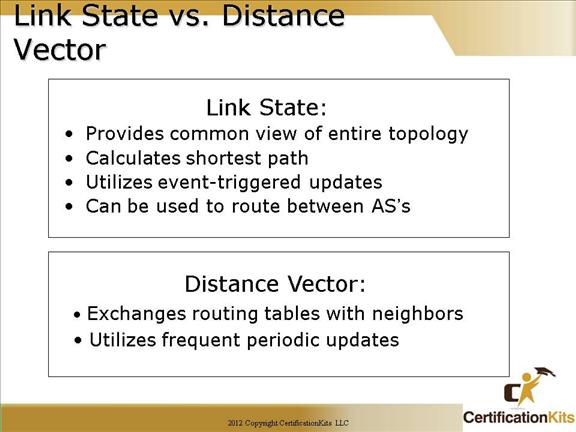
This slides represents some important Link State characteristics, compared to Distance Vector.
Remember Link State routing protocols are more CPU intensive but they converge faster than Distance Vector routing protocols and are less bandwidth intensive since they do not send out periodic updates. Distance Vector routing protocols, like RIP, are prone to choosing a less efficient path to be placed in the routing table since the only metric utilized is hop count. This is more likely to occur when there is a numerous different link speeds in the path.
